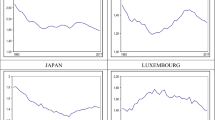Abstract
Using recent developments in time-series econometrics, this paper investigates the behavior of fertility over the business cycle. The sex-specific unemployment rates, the divorce rate and the fertility rate are shown to be governed by stochastic trends. Furthermore, fertility is determined to be cointegrated with the divorce rate.
In the bivariate vector-autoregressions between fertility and unemployment, an increase in the female or male unemployment rates generate a decrease in fertility, which is consistent with the findings of previous time-series research concerning the procyclical behavior of fertility. However, when the models include the divorce rate and the proportion of young marriages as additional regressors, shocks to the unemployment rates bring about an increase in fertility, implying the countercyclicality of fertility. This outcome holds for the time period 1948–1982, as well as 1972–1982.
Similar content being viewed by others
References
Ben-Porath Y (1973) Short-term fluctuations in fertility and economic activity in Israel. Demography 10:185–204
Breusch TS (1978) Testing for autocorrelation in dynamic linear models. Aust Econ Pap 17:334–355
Butz WB, Ward MP (1979) The emergence of countercyclical U.S. fertility. Am Econ Rev 69:318–328
Campbell JY, Mankiw NG (1987) Are output fluctuations transitory? Qu J Econ 102:857–880
Clark P (1987) The cyclical component in U.S. economic activity. Qu J Econ 102:797–814
Cochrane J (1988) How big is the random walk in GNP? J Polit Econ 96:893–920
Cohen SB, Sweet JA (1974) The impact of marital disruption and remarriage on fertility. J Marr Family 36:87–96
Dickey DA, Fuller WA (1981) Likelihood ratio statistics for autoregressive time series with a unit root. Econometrica 49:1057–1072
Eckstein Z, Schultz TP, Wolpin KI (1985) Short-run fluctuations in fertility and mortality in pre-industrial Sweden. Eur Econ Rev 26:295–317
Engle RF, Granger CWJ (1987) Co-integration and error correction: Representation, estimation, and testing. Econometrica 55:251–276
Engle RF, Yoo BS (1987) Forecasting and testing in co-integrated systems. J Economet 35:143–159
Galbraith VL, Thomas DS (1941) Birth rates and the interwar business cycles. J Am Stat Assoc 36:465–476
Godfrey LG (1978) Testing for higher order serial correlation in regression equations when the regressors include lagged dependent variables. Econometrica 46:1303–1310
Gordon RJ, King SR (1982) The output cost of disinflation in traditional and vector autoregressive models. Brook Pap Econ Act 1:205–242
Hakkio CS, Morris CS (1984) Vectorautoregressions: A user's guide. FED Kansas City RWP 84-10
Hyrenius H (1946) The relation between birth rates and economic activity in Sweden 1920–1944. Bull Oxford Univ Instit Econ Stat 8:14–21
Keeley M (1977) The economics of family formation: An investigation of the age at first marriage. Econ Inq 20:238–250
Keeley M (1979) An analysis of age pattern of first marriage. Int Econ Rev 20:527–544
Kirk D (1960) The influence of business cycles on marriage and birth rates. In: Demographic and economic change in developed countries. NBER, Conference Series II. Princeton University Press, Princeton, New Jersey
Koo HP, Janowitz BK (1983) Interrelationships between fertility and marital dissolution: Results of a simultaneous logit model. Demography 20:129–145
Litterman RB (1979) Techniques of forecasting using vector-autoregressions. Fed Minneapolis WP 115
Lütkepohl H (1982) Non-causality due to omitted variables. J Economet 19:367–378
Macunovich DJ, Easterlin RA (1988) Application of Granger-Sims causality tests to montly fertility data, 1958–1984. J Popul Econ 1:71–88
Nelson CR, Kang H (1984) Pitfalls in the use of time as an explanatory variable in regression. J Bus Econ Stat 2:73–82
Nelson CR, Plosser CI (1982) Trends and random walks in macroeconomic time series. J Monet Econ 10:139–162
Pierce DA (1977) Relationships — and the lack thereof — between economic time series, with special reference to money and interest rates. J Am Stat Assoc 72:11–21
Shapiro MD, Watson MW (1988) Sources of business cycle fluctuations. NBER, Macroeconomics Annual 1988. MIT Press Cambridge, Massachusetts
Silver M (1965) Births, marriages and business cycles in the United States. J Polit Econ 73:221–255
Sims CA (1972) Money, income and causality. Am Econ Rev 62:540–552
Sims CA (1977) Exogeneity and causal ordering in macroeconomic models. New methods in business cycle research: Proceedings from a conference. Fed Minneapolis, Minneapolis
Sims CA (1980) Macroeconomics and reality. Econometrica 48:1–48
Stock JH, Watson MW (1988) Variable trends in economic time series. Econ Perspectives 2:147–174
Thomas DS (1927) Social aspects of the business cycle. Alfred A Knopf, New York
Thornton A (1978) Marital dissolution, remarriage, and childbearing. Demography 15:361–380
Yule GU (1906) On changes in the marriage- and birth-rates in England and Wales during the past half century. J R Statist Soc 69:88–132
Zellner A (1979) Causality and Econometrics. Carn-Roch Confr Series Publ Pol 10:9–54
Author information
Authors and Affiliations
Additional information
I would like to thank Clive Granger, Michael Grossman, Theodore Joyce, Salih Neftei, Jeffrey Zax and two anonymous referees for helpful comments. Any errors reflect my shortcomings only. This paper is the revised version of the National Bureau of Economic Research Working Paper No. 3177. It has not undergone the review accorded official NBER publications; in particular, it has not been submitted for approval by the Board of Directors.
Rights and permissions
About this article
Cite this article
Mocan, N.H. Business cycles and fertility dynamics in the United States. J Popul Econ 3, 125–146 (1990). https://doi.org/10.1007/BF00187288
Received:
Accepted:
Issue Date:
DOI: https://doi.org/10.1007/BF00187288




